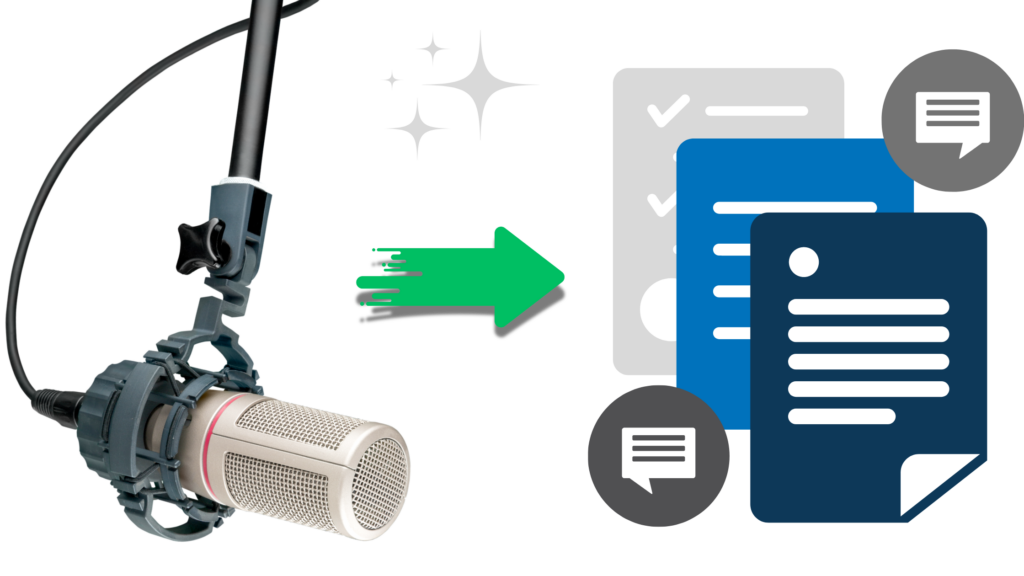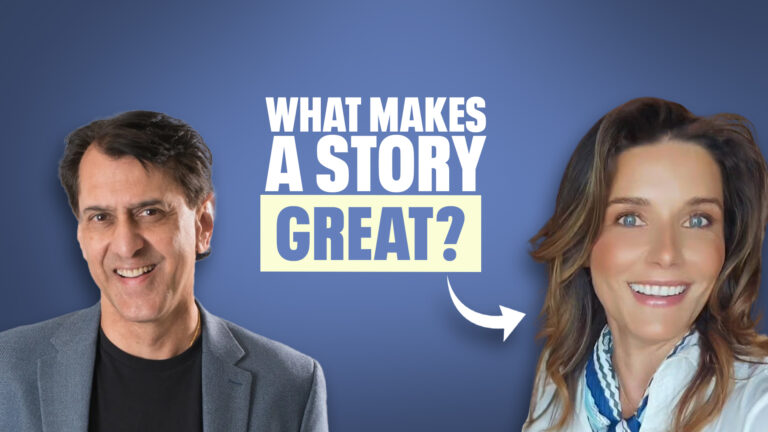Your next promotion, investment round, or major client deal might depend on your B2B storytelling skills. Most business leaders think they lack compelling stories and narratives, yet they’re sitting on experiences that could transform their careers and companies.
In this article and accompanying podcast, you’ll learn how to tell a great business story that keeps your audience engaged. Business storytelling has evolved from optional content creation to a necessity for executive success. The difference between leaders who get recognized and those who remain invisible often comes down to their ability to share authentic, compelling narratives.
Table of Contents
Executive Signal Podcast with Patrice Poltzer
Watch my full podcast with Patrice Poltzer below, or on Youtube, Apple Podcasts or Spotify.
Why B2B Storytelling Became Non-Negotiable for Executives
Ever since modern day AI entered the workplace, the way we work has shifted dramatically. AI is slowly eliminating jobs across numerous industries. The good news is that executives can remain irreplaceable through their unique perspectives, amplified through B2B storytelling, and human connections that technology cannot replicate.
Patrice Poltzer, former Today Show producer and founder of a video storytelling agency, witnessed this transformation firsthand when working with a Chicago media company executive. Despite his company outperforming competitors in key metrics such as revenue, profit, and growth, he walked into a major bank meeting where nobody recognized him.

“He spent the first five to ten minutes rather awkwardly answering questions like, ‘Wait, who are you?'” Poltzer recalls.
That moment sparked his realization that superior performance means nothing without the ability to communicate your story effectively.
After working with Poltzer to develop his B2B storytelling approach, posting quality content just once or twice weekly, industry leaders began approaching him at conferences. Kara Swisher called out his company as her favorite daily read, and he was invited to speak at major conferences including South by Southwest and Cannes.
Read my guide on Business Storytelling Frameworks
(It's filled with examples you can model)
This Prompt Uncovers Hidden Stories in Everyday Business Moments
Most executives dismiss their daily experiences as mundane, yet these moments contain the raw material for powerful business storytelling. The key lies in asking specific questions that push beyond surface-level events.
Poltzer suggests starting with targeted prompts that get you thinking differently:
- Tell me about a moment when you made a decision and knew it was wrong
- Tell me about a moment when you had to choose between easy and right
- Tell me about a moment in your industry when you made an unpopular decision
- Tell me about a moment when you had to make a difficult layoff you didn’t want to do
These questions force you beyond generic business lessons into specific, memorable moments that actually connect with people.
START A STORY IN THE MIDDLE
Here's how one cybersecurity company CEO built his entire brand around a single story. Rather than opening presentations with boring industry statistics about data breaches, he used Poltzer's exact framework:
"I got a text in the middle of the night at 2:00 am. All your bank accounts have been hacked and none of your logins work anymore."
This opening immediately established stakes that every business leader could relate to – the nightmare of losing everything overnight. The emotional connection was instant, and prospects wanted to ensure they never experienced that same terror.
The power resided in the specificity. He continued with sensory details: “I saw a text on my phone stare at me at two in the morning. I felt dread, I felt a knot in my stomach.” Those details transported listeners directly into that moment with him.
“Generic lessons without emotion, no one is going to remember that,” Poltzer explains, emphasizing why the emotional details matter so much more than the facts.
Aspiring Executives: Move Beyond Facts to Create Emotional Resonance

Traditional business communication focuses on data and outcomes, but effective business storytelling requires acknowledging feelings and personal responsibility in difficult situations. Many executives struggle with this shift from purely factual reporting to incorporating emotional elements into their professional narratives.
An Apple product manager discovered this principle when she began incorporating personal elements into team meetings. After 12 years with the company, she started taking five minutes before project updates to explain why she felt passionate about their collaborative work.
She revealed that her father left when she was young, her mother worked overnight shifts in Las Vegas, and she essentially raised herself. This childhood chaos created her deep need for stability and structure, which were the same skills she brought to managing complex product development cycles.
Initially, sharing personal details with her global team felt awkward. However, something powerful occurred. Team members started reaching out privately, sharing their own similar experiences. Meetings became more collaborative, and people felt permission to bring authenticity to their professional interactions.
Within months, she was featured in Apple’s global newsletter, approached for a promotion interview, and eventually selected to lead training initiatives in Saudi Arabia. Her transformation came from learning to weave personal narrative into her leadership approach strategically.
Leveraging Customer Success Stories for B2B Impact
Sometimes your most compelling B2B storytelling comes from customer transformations rather than personal experiences. These narratives can feel less self-promotional while showcasing expertise and tangible results.
“The best founder stories always understand that you are acting as a mirror to your most perfect customer,” Poltzer notes, explaining why customer stories work so effectively in business contexts.
You usually have an endless supply of customer stories. You just have to ask a simple question like “Tell me about the last time you logged into our product. What were you looking to do?”
My Non-Profit Donor Story That Generated Millions
I learned this lesson at one of my previous company’s WealthEngine, which provided donor data to nonprofits. Instead of leading with database accuracy statistics, we focused on transformation stories that prospects could envision for themselves.

One nonprofit identified a family they believed might donate a few thousand dollars to their capital campaign. Our wealth data revealed this family could actually contribute over one million dollars. The nonprofit adjusted their approach, invited the family for a campus tour, and presented their vision more boldly.
Two months later, they received a $5 million donation.
This story accomplished what technical specifications never could. It helped prospects think, “I want that to be my story.” The data became secondary to the human impact and organizational transformation potential.
When telling customer stories in your business storytelling, focus on emotional journey and specific outcomes rather than product features. Your audience cares about results they can achieve, not the mechanics of how you deliver them.
The Structure That Makes B2B Storytelling Memorable
“Stories always have to involve a change… a change internally in the way you think, or it can be a change externally in the environment,” Poltzer explains.
Effective business storytelling follows a proven structure that maximizes retention and impact:
| Story Element | Purpose | Example |
| Stakes Setting | Immediate attention | “2 AM text: all systems down” |
| Sensory Details | Emotional connection | “Staring at phone, knot in stomach” |
| Moment of Truth | Turning point | “Realized data could be gone forever” |
| Resolution | Lesson/Application | “Built solution to protect others” |
Start by establishing stakes immediately. Skip lengthy background context or industry explanations. Jump directly into the moment of highest tension or emotion.
After setting stakes, transport your audience into that specific moment through sensory details. What did you see? How did you feel? These elements create what neuroscientists call “neuro-coupling.” This is the only form of communication that actually synchronizes brainwaves between speaker and listener.
“You always want to hook a story on a moment,” Poltzer notes. “Maybe two, but you pick the one moment that you’re going to tell for this particular story.”
The moment of truth represents your turning point, where you realized something needed to change or discovered a new approach. This section contains the learning for both you and your audience.
Finally, connect the resolution to your audience’s needs. What does your experience mean for them? How can they apply your insight to their own challenges?
The “Greatest Hits” Strategy for Consistent B2B Storytelling
Many executives worry about repetition, yet this concern ignores fundamental truths about human memory and attention spans. People need to hear messages hundreds of times before retention occurs, especially in our content-saturated environment.
Musicians understand this principle. Audiences expect to hear signature songs at concerts. Madonna must play “Like a Prayer.” Coldplay must perform “Yellow.” These artists know people came to experience familiar, beloved content.

Sara Blakely, Spanx (now Sneex) founder, demonstrates this approach in B2B storytelling. She repeatedly tells her origin story: going door to door, cutting feet off pantyhose, facing constant rejection. She shared this narrative again recently on LinkedIn, generating massive engagement because the story continues to resonate.
“If you are sick of telling that story, that is a great thing because you should be. That’s when people are going to remember you,” Poltzer notes.
Develop your “greatest hits” collection: ten core stories that capture your key messages and values. These become foundational content you can adapt for different audiences and platforms while maintaining consistent messaging that builds recognition over time.
“Most of the time people put too much backdrop into it,” Poltzer warns about common storytelling mistakes. “They take too long to get to the actual meat.”
The Chicago executive’s transformation illustrates this principle. Rather than constantly creating new content, he focused on sharing authentic stories only he could tell, positioned to help his audience rather than promote himself. Quality and consistency trumped quantity and novelty.
Implementing Business Storytelling in Corporate Settings
Not every business storytelling opportunity occurs on social media or conference stages. The most powerful applications often happen in everyday corporate communications like team meetings, investor updates, client presentations.
The Apple product manager’s approach demonstrates how to integrate stories into regular business interactions without appearing unprofessional. She made small adjustments that compounded over time rather than dramatically overhauling her communication style.
During weekly team meetings with colleagues across different time zones, she spent five minutes sharing what moments that week reminded her of their bigger mission before diving into project updates. These are “micro stories.”
Micro-stories serve two big strategic purposes:
1. Make you more memorable to colleagues across departments and geographies
2. Give team members permission to share their own perspectives and experiences
The key lies in matching story choices to your core values and desired professional reputation. Every narrative you share should reinforce how you want people to remember you and your leadership approach.
Making Your Stories Work Harder for Your Business
Poltzer’s own experience demonstrates the unexpected power of business storytelling reach. She hired a marketing person for her AI storytelling company, and among several qualified candidates, she chose a single mother of four children.
“As soon as she said she was a single mom, and I knew the stuff that she had done for other people, she was my person because I saw my own mother,” Poltzer explains. Her mother had been a single parent for many years, creating an instant connection based on shared experience and understanding.

This hiring decision illustrates how personal stories create unexpected professional connections. The woman Poltzer hired had no idea her personal situation would resonate so strongly with a potential employer.
Even seemingly small story moments can have significant impact. Poltzer shared a LinkedIn post about buying a hat, which prompted me to reach out for this interview. You never know which narrative will create the next important connection or opportunity.
“People’s brains cannot take in that much information. They’re not going to remember, even if it’s an amazing story, people are only going to remember probably one big thing,” Poltzer reminds us about the importance of focusing your message.
How to Build Your B2B Storytelling Foundation
Your next career breakthrough waits in a story you haven’t told yet. Begin by documenting answers to specific questions:
- What moment changed how you think about your industry?
- When did you choose between easy and right?
- What customer transformation made you proud of your work?
“Being vulnerable isn’t just acknowledging hard things. Being vulnerable is actually acknowledging your role in that hard thing and what your responsibility was,” Poltzer emphasizes.
Start small by sharing one meaningful moment in your next team meeting or client conversation. Pay attention to audience response and which stories generate engagement or follow-up questions.
Business storytelling improves with practice, and developing your narrative skills becomes increasingly important in today’s competitive marketplace. Executives who master this approach in their B2B storytelling efforts build stronger personal brands, create deeper connections, inspire better teamwork, and drive superior business results. Your stories become your competitive advantage in an increasingly automated business environment.
The time to start sharing them is now.
Use MakeMEDIA’s B2B Executive Interview Tool

Answering questions that build your foundational stories is easier when you’re being interviewed. MakeMEDIA’s executive onboarding interview researches your background and then hones in on questions to help fill the gaps that create your personal brand. It also creates details personas and content plans that align with your intended audience.
MakeMEDIA then uses this training to design new interviews to create authentic LinkedIn posts, newsletters and SEO-rich articles that build your visibility, credibility, and pipeline.

